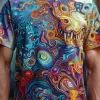
Screen-Printed T-Shirts: 6 Steps of Evolution
Screen-Printed t-shirts, also known as silk screening, is a printing technique that dates back to ancient China, where it was first used to transfer designs onto fabric. The process involves creating a stencil on a mesh screen, which is then used to transfer ink onto a substrate, such as fabric or paper. The earliest known examples of screen printing can be traced back to the Song Dynasty (960-1279 AD), where it was used to print intricate designs on silk fabrics.
The technique eventually made its way to Europe in the 18th century, where it gained popularity as a method for printing on textiles and wallpaper. However, it wasn’t until the early 20th century that screen printing truly began to take off as a commercial printing method.
In the 1910s, a group of artists in Germany known as the “Brücke” group began using screen printing to create bold, graphic prints that were unlike anything that had been seen before. This marked the beginning of screen printing’s association with avant-garde art and design.
The Rise of Screen-Printed T-Shirts in Fashion
In the 1950s, screen-printed T-shirts began to gain popularity as a form of self-expression and personal style. The rise of rock and roll and the counterculture movement of the 1960s brought about a surge in demand for custom T-shirts featuring bold, colorful designs.
Bands and artists began using screen-printed T-shirts as a way to promote their music and connect with their fans. This led to the emergence of T-shirts as a form of wearable art, with designs ranging from political statements to psychedelic imagery.
By the 1970s, screen-printed T-shirts had become a staple of fashion, with designers and brands incorporating them into their collections. The DIY ethos of screen printing also contributed to its appeal, as it allowed individuals to create their own unique designs at home. This democratization of design helped to further popularize screen-printed T-shirts as a form of personal expression.
The Influence of Art and Design on Screen-Printed T-Shirts
Art and design have played a significant role in shaping the evolution of screen-printed T-shirts. From the bold, graphic prints of the 1960s to the minimalist designs of today, screen-printed T-shirts have been a canvas for artistic expression. Artists such as Andy Warhol and Roy Lichtenstein embraced screen printing as a medium for their work, creating iconic prints that have become synonymous with the medium.
In the world of fashion, designers have also embraced screen printing as a way to create unique and eye-catching designs. Brands such as Supreme and Stüssy have built their entire aesthetic around screen-printed T-shirts, using bold graphics and logos to create a strong visual identity.
The influence of art and design on screen-printed T-shirts can also be seen in the rise of collaborations between artists and fashion brands, with limited edition T-shirts featuring exclusive designs becoming highly sought after by collectors.
Innovations in Screen Printing Technology
Advancements in technology have played a crucial role in the evolution of screen printing. Traditional screen printing methods involved creating stencils by hand and manually applying ink to the substrate. However, modern advancements in digital printing have revolutionized the process, allowing for more complex and detailed designs to be printed with greater precision.
Digital screen printing technology has also made it possible to print on a wider range of materials, including plastics, glass, and metal. This has opened up new possibilities for designers and manufacturers, allowing them to create innovative products that were previously not possible with traditional screen printing methods. Additionally, advancements in ink formulations have led to the development of eco-friendly and sustainable options, further expanding the potential applications of screen printing.
The Role of Screen-Printed T-Shirts in Pop Culture
Screen-printed T-shirts have played a significant role in shaping pop culture, serving as a canvas for expressing individuality and making bold statements. From band merchandise to political slogans, T-shirts have been used to convey messages and connect with like-minded individuals. In recent years, screen-printed T-shirts have also become a platform for social activism, with designers and brands using their designs to raise awareness about important issues such as climate change and social justice.
The influence of screen-printed T-shirts in pop culture can also be seen in their presence in film and television. Iconic T-shirts featuring memorable designs have become synonymous with certain characters and moments in popular media, further cementing their status as cultural artifacts. Additionally, the rise of streetwear culture has propelled screen-printed T-shirts into the mainstream, with celebrities and influencers often spotted wearing limited edition designs from coveted brands.
Sustainability and Ethical Practices in Screen Printing
As consumer awareness about environmental issues continues to grow, there has been an increased focus on sustainability and ethical practices within the screen printing industry. Traditional screen printing methods often involve the use of harsh chemicals and large amounts of water, leading to negative environmental impacts. However, advancements in technology have led to the development of more sustainable alternatives, such as water-based inks and energy-efficient printing processes.
In addition to environmental concerns, there has also been a push for ethical practices within the industry, particularly in regards to labor conditions and fair wages. Many consumers are now seeking out brands that prioritize ethical production methods and transparency in their supply chain. This has led to an increase in demand for screen-printed T-shirts that are produced in accordance with fair labor standards and environmentally friendly practices.
The Future of Screen-Printed T-Shirts: Trends and Forecast
Looking ahead, the future of screen-printed T-shirts is likely to be shaped by advancements in technology and changing consumer preferences. As digital printing continues to evolve, we can expect to see even more intricate and detailed designs being produced on T-shirts.
Additionally, the demand for sustainable and eco-friendly options is likely to drive further innovation within the industry, leading to the development of new materials and processes that minimize environmental impact.
In terms of design trends, we can expect to see a continued focus on bold graphics and statement-making prints. Collaborations between artists and fashion brands are also likely to become more prevalent, resulting in limited edition T-shirts that blur the lines between art and fashion.
Furthermore, the rise of customization and personalization is expected to play a significant role in shaping the future of screen-printed T-shirts, with consumers seeking out unique designs that reflect their individual style.
In conclusion, screen-printed T-shirts have come a long way since their humble origins in ancient China. From their early use as a method for transferring intricate designs onto fabric to their current status as a form of wearable art and cultural artifact, screen-printed T-shirts have left an indelible mark on fashion and pop culture. As technology continues to advance and consumer preferences evolve, it will be fascinating to see how this timeless medium continues to adapt and thrive in the years to come.
Check Our Collection: Vintage T-Shirts








Add comment